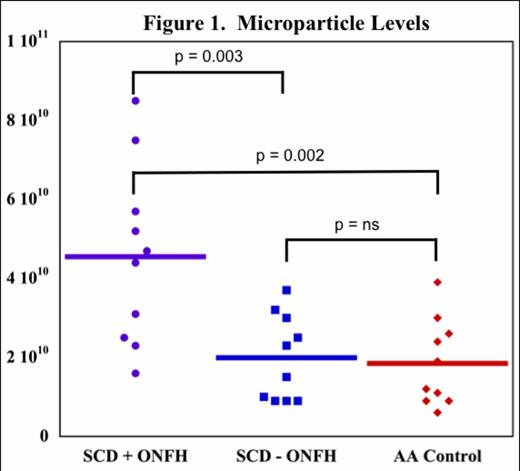Abstract
Sickle cell disease (SCD) is the most common cause of osteonecrosis of the femoral head (ONFH) in children. ONFH is a debilitating condition that is associated with mobility limitations, chronic pain, and an impaired quality of life. While the mechanisms that cause ONFH remain unknown, ischemia from recurrent microvascular occlusion is likely to play a role. Vascular occlusion may result directly from obstruction by sickled cells, or indirectly via complex interdependent pathways characterized by sustained endothelial activation, chronic inflammation, and coagulation. Microparticles (MP) are small, cell membrane-derived vesicles generated in response to cellular activation, injury or apoptosis. MPs have emerged as potential modulators of inflammation and thrombosis and have been found to be elevated in patients with ONFH in the general population.
This pilot study examined whether microparticle levels in patients with SCD who have ONFH differ from SCD patients without ONFH, as well as healthy African American (AA) controls.
Subjects were recruited at their baseline status and were excluded if they had been transfused within the past 30 days, hospitalized for a vaso-occlusive pain episode, acute chest syndrome, fever or surgery within the past 30 days, or had bony lesions of the femur or hip due to causes unrelated to SCD. For MP analysis, whole blood was collected in sodium citrate tubes and centrifuged for 15 minutes at 1500 x g at 20° C to generate platelet poor plasma. Aliquots of the plasma were immediately frozen and stored at -80° C until the time of MP analysis. 300 μl samples were diluted in PBS and centrifuged at 10000 x g for 1hr and the supernatant was centrifuged at 100,000 x g for 2 hr. The pellet was re-suspended in 1 mL of PBS and subjected to nanoparticle-tracking analysis to determine concentration and size. Additional laboratory biomarkers of inflammation and coagulation, including highly-sensitive C-reactive protein (hs-CRP), von Willebrand factor antigen (vWF Ag), tissue factor (TF), and D-dimer were analyzed for differences between groups. Analysis of variance was used to compare MP and biomarker levels between the three groups. The institutional review board at Children's Hospital & Research Center Oakland approved the study protocol and written informed consent was obtained from all participants.
Characteristics of the 30 subjects enrolled are shown in Table I.
Total microparticle levels in ONFH(+) patients were 2.3-fold higher than in ONFH(-) patients, and 2.5-fold higher than in AA controls (Figure 1). Mean MP levels for ONFH(+) patients, ONFH(-) patients, and AA controls were 4.55 x 1010, 1.99 x 1010, and 1.85 x 1010, respectively. Microparticle levels in ONFH(-) SCD patients did not differ from AA controls. There were no statistically significant differences in hsCRP, vWF Ag, TF, or D-dimer levels between the ONFH(-) and ONFH(+) groups.
The results of this study demonstrate significantly elevated MP levels in individuals with SCD who have ONFH. Additional studies are needed to better understand the mechanistic effects of MPs on the development of ONFH and to determine whether MP levels may be useful as a predictive biomarker for early disease detection.
This publication was supported by NIH/NCRR UCSF-CTSI Grant Number UL1 RR024131.
No relevant conflicts of interest to declare.
Author notes
Asterisk with author names denotes non-ASH members.



This feature is available to Subscribers Only
Sign In or Create an Account Close Modal